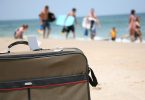Despite a stronger currency in both markets, more Canadians are flocking to Hawaii while Japanese arrivals continue to fall
Visitors from Canada and Japan have benefited from a 16 percent improvement in their consumer buying power due to the strengthening of their currencies against the dollar.
However, the similarities end there.
When comparing what the currency impact will be for Canada and Japan, it really comes down to a tale of two markets. Right now, experts say that it is among the very best of times for the Canada visitor market, which saw arrivals rocket 27 percent in January and last year posted its highest market share in a decade in Hawaii.
On the other hand, despite favorable exchange rates, many consider this to be the worst of times for arrivals from Japan, which hit a decade low in market share last year and continues to post lower visitor counts.
The strength of the Canadian market has propelled visitors to start behaving like the Japan market of old. Hoteliers and members of Hawaii’s visitor industry report that Canadians have begun to upgrade their Hawaii trips and that per-person, per-day spending and per-trip spending from Canada is at a 10-year high. The favorable exchange rates have created more visitor momentum from Canada, and that’s begun to spur demand for Hawaii second home and resort properties. Canadians are even paying cash for their properties.
It’s almost as if the Canada and Japan markets have swapped. While per-person, per-day and per-trip spending is also at a 10-year high from Japan, in this case the higher costs may have begun to produce some price sensitivity.
Japanese travelers can get greater yield for their yen from emerging destinations in Thailand, South Korea and China. There’s still plenty of demand for Hawaii as a visitor and second-home destination from Japanese consumers. However, in order to capitalize on improved currency-exchange rates and get increased business from Japan, Hawaii’s visitor industry will have to communicate value.
O CANADÀ
The number of Canadian visitors increased in 2007 over 2006 despite a reduction in available commercial airline seats.
COUNTRY SEATS 2007 PCT. CHANGE FROM 2006 ARRIVALS PCT. CHANGE
Canada 304,393 -17.7% 288,150 +5.3%
Japan 1,851,850 +1.9% 1,300,000 -3.5%
In the old days, Canadian tourists were apt to arrive in Hawaii with suitcases filled with soup cans to make their long stay more economical. Now, some of them have suitcases full of cash.
“There’s talk that they are driving around the Big Island offering cash for houses,” said Manu Spaur, broker/owner of RE/MAX Island Surf Realty in Pahoa on the Big Island. “Currency improvements have created tremendous interest from this market.”
Visitors from Canada and Japan have benefited from a 16 percent improvement in their consumer buying power due to the strengthening of their currencies against the dollar. However, while these changes have caused the Canadian market to soar, other challenges have continued to ground the Japan market.
Comparing the currency impact on the Canada and Japan visitor source markets comes down to a tale of two markets. Right now, experts say that it is among the very best of times for the Canada visitor market, which saw arrivals rocket 27 percent in January. On the other hand, despite favorable exchange rates, many consider this to be the worst of times for arrivals from Japan. The market share of visitors from Japan fell to a decade low last year and arrivals continue to decline.
“Any strengthening in the currency from Japan is probably going to be a wash,” said Rex Johnson, president of the Hawaii Tourism Authority. “They are hitting the fuel surcharge again. Also, everything here is a little more expensive and you can buy it in Japan.”
In the mid- to late 1980s and the mid-1990s, Hawaii saw a substantial increase from Japan visitors when the yen improved, said Joe Toy, president of Hospitality Advisors LLC. When the yen dropped to 86 against the dollar in 1996, Hawaii saw a sharp increase in visitors and set a 1997 record, Toy said.
“It’s a different situation now,” Toy said. “We have a stronger yen but it’s a more competitive landscape and the Japanese have become very seasoned travelers. The currency movement is not likely to have as great an impact as before.”
In the late 1990s, when the Japanese tourism boom to Hawaii was taking off, the state’s largest industry went to great lengths to cater to these nouveau rich of Asia who were known to spend four times more than any other visitor market. Then, the bubble burst and Japanese visitors went through a trying time. Japanese visitor arrivals to Hawaii, which peaked at 2.2 million in 1997, fell to 1.3 million last year — the lowest tallies in almost two decades.
Now, most Japanese visitors who come to Hawaii keep their spending in closer range of other source markets and are far more conscious of price and quality. While posh tourists are still coming from Japan and they are still buying Hawaii real estate, they have adopted the shopping habits of their western counterparts. Today’s Japan consumer, be they a tourist or a real estate buyer, wants to see value served alongside their high-end food and beverage, retail and luxury hotel rooms
While per-person, per-day and per-trip spending is also at a 10-year high from Japan, in this case, the higher costs may have begun to produce some price sensitivity. Even the upcoming Golden Week, which traditionally is one of the stronger travel periods for the Japanese, is projected to be down 40 to 50 percent in April and flat in May, said Akio Hoshino, senior vice president for Jalpak in Hawaii.
“Consumers are getting more and more price conscious and the April Golden Week travel period is about $300 more than other April travel dates,” Hoshino said.
While a strong yen will help Japan visitors in Hawaii, it doesn’t necessarily impact booking demand or make tour prices more economical, Hoshino said.
“Wholesalers purchase their travel in advance, so at the time the yen wasn’t as strong,” he said. “If the yen continues to remain strong, it might be good for the Japanese tourists.”
There’s still plenty of demand for Hawaii as a visitor and second-home destination from Japanese consumers. However, Hawaii’s visitor industry will have to communicate value if it wants to capitalize on improved currency exchange rates and get increased business from Japan.
“Even with the currency change, we aren’t projecting any increases out of Japan,” said State Tourism Liaison Marsha Wienert. “Our goal is just to stabilize that market.”
A rise in hotel costs and airline surcharges has caused many Japanese visitors to consider booking vacations in emerging destinations like Thailand, South Korea and China where they will have the perception of getting greater yield for their yen, said Danny Ojiri, vice president of sales and marketing for Japan for Outrigger Enterprises Group.
“In the last four or five years there have been other destinations that have emerged, but many of them have had terrorism or bird flu concerns,” Ojiri said. “Hawaii, however, remains a top choice for these travelers as long as they can identify the value.”
Since opening the Waikiki Beach Walk and offering new hotel product, Outrigger has seen its market share from Japan grow by 6 percent, Ojiri said.
“Our product is moving into the zone of preference,” Ojiri said. “Our price point is higher because our product has been transformed. They don’t mind paying for improvements such as larger rooms and enhanced services.”
On the other hand, the Canadian market has been so strong since the currency change that even with a 17.7 percent reduction in air seats in 2007, the market still posted a 5.3 percent calendar- year increase in arrivals, said Chris Kam, director of market trends for the Hawaii Visitors and Convention Bureau.
“When they can’t find a seat in Canada, they are taking domestic flights,” Kam said. “It’s too far to swim but there’s nothing wrong with crossing the border to catch a flight to Hawaii.”
Last year, 133,683 out of 288,150 Canadian visitors to Hawaii arrived on a flight from the U.S. mainland, Kam said. The number of Canadians coming onboard international flights was down 15.6 percent in 2007, but the number of them coming onboard U.S. flights was up 47.7 percent, he said.
“We’ve been coming here twice a year for more than 20 years,” Marg Bartel of Vancouver, B.C., said as she waited to collect her bags on Thursday. “Pretty soon, maybe we’ll be saying that this is home”
While Bartel and her husband John, and their friends Frank and Elma Pauls, plan to enjoy the increase in buying power this trip, they said it wasn’t the deciding factor for their visit to Hawaii.
“We came even when we had no money,” Frank Pauls said.
Compared to other top choices of Canadian travelers such as Australia, the mainland United States, Mexico and the Caribbean, Hawaii stacks up well both in terms of price and quality, Wienert said.
“We’re a bargain compared to Australia and we offer more quality than Mexico and the Caribbean,” she said. “Hawaii also is seen as being more exotic than the mainland United States.”
Canadian visitors, who make up Hawaii’s fourth-largest market after the U.S. West, U.S. East and Japan, are expected to continue growing market share as they enjoy a prosperous home economy flush with oil money and rising home valuations, Wienert said.
“Canadians are buying up more luxury than ever,” said David Carey, president and chief executive of Outrigger Enterprises Group. “They used to arrive with a suitcase full of soup cans, but no more.”
Now, not only are Canadians filling Hawaii’s top hotels, but they are picking up real estate, too. In the last two to three months, 100 or so of the statewide real estate tax bills for new purchases have gone to Canada, said David Buck, an agent with RE/MAX 808 Realty in Honolulu.
“I am now getting one to two Canadian buyer leads every other day looking to purchase real estate here in Honolulu,” Buck said. “There is a lot of money coming out of Calgary and Alberta. Their currency has bumped up and they are wealthy from oil. Also, Calgary home prices have doubled in the last two to three years.”
The positive visitor fundamentals out of Canada have created a second home and resort real estate source market that mirrors Hawaii’s most recent California real estate and visitor boom, he said.
“Right now, 60 to 70 percent of my Internet inquiries are out of Canada,” Buck said.
However, despite the strength of their dollar, most Canadian buyers aren’t making huge purchases, he said.
“I’ve seen a few $5 (million) and $6 million transactions, but most tend to be in the $300,000 to $400,000 range,” Buck said. “Typically, these buyers have to use home equity or pay cash to complete their purchases because they don’t have a credit history in the United States.”
starbulletin.com






















